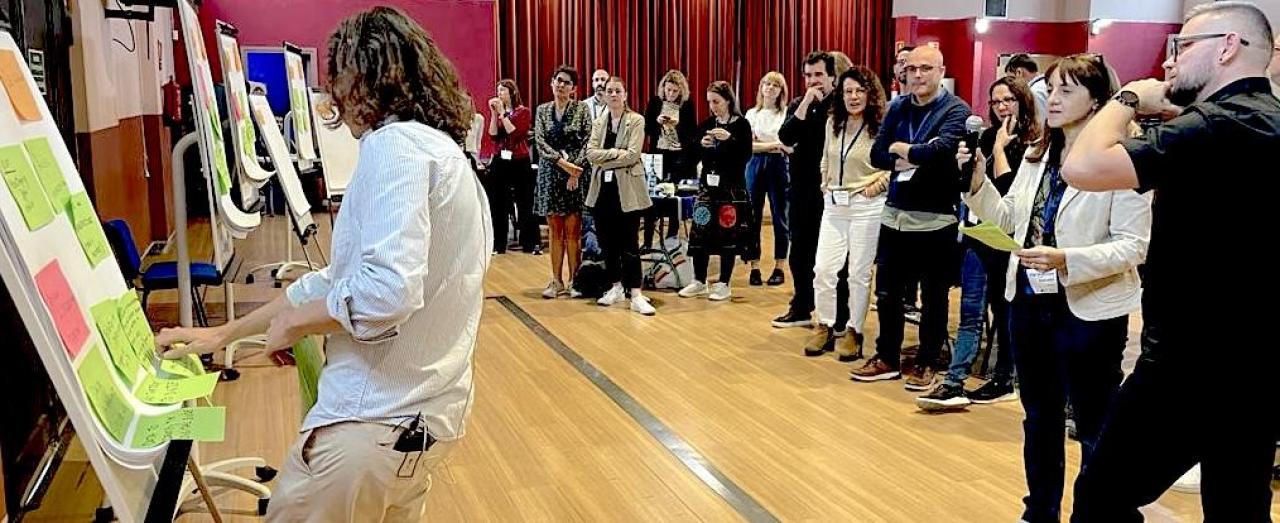Digital is not for everyone… (yet!)
The accelerated digital transition happening across Europe is creating societal imbalances, affecting both those who are excluded already, and also creating newly-excluded groups.
Digital transition is essential to boost economic growth and improve the quality of life of citizens, but this transition by itself does not ensure that all citizens benefit equally. Indeed a significant number of citizens are actively excluded as a result of these rapid changes in digital technology.
This is the “digital divide” – where certain groups and individuals cannot or do not make full use of digital opportunities (whilst others can and do). This leads to people being digitally excluded from aspects of society that are conducted online or in the digital space.
In the modern world, digital exclusion is not just a matter of missing a few opportunities – it results in social and economic exclusion, where certain individuals or groups are unable to fully participate in society. It can even affect their democratic participation too.
The Digi-Inclusion network aims to help cities reduce this social exclusion by bridging the digital divide.
A Real Digital Challenge
To put this divide into context, data from Eurostat shows that in 2022 58 million EU citizens have still never accessed the internet – equivalent to 7% of the population aged 16-74. In some regions of Greece, Italy and Bulgaria etc. this figure rises to between 15 and 20% - a huge portion of the local populations.
And it's not just the south west of Europe. For example, whilst access to the internet is generally better in the north of the EU, according to the Belgian “Digital Inclusion Barometer” - published by experts from Catholic University of Leuven (UCLouvain) and the Free University of Brussels (VUB) - an increasing number of people in the country are now “socially handicapped” by their lack of digital skills and it classified a staggering 46% of the Belgian population from 16-74 as “digitally vulnerable” i.e. lacking essential digital skills. It also noted that this figure has increased in the previous two years by approximately 7%, reflecting that more people get left behind as technology advances and they don’t or can’t keep up.
Social Challenges in a Digital World
But, you may ask… why is this issue so important for cities specifically? It’s a case of both increasing policy drivers and societal and economic imperatives.
In its publication “2030 Digital Compass: the European way for the Digital Decade” the European Commission highlights that technologies are now essential for working, learning, entertaining, socialising, shopping and accessing everything from health services to culture.
It also puts digital transition at the core of EU policy. We will all be operating within this framework and need to respond accordingly in our local policies and actions, to minimise the negative impacts of digital transition.
We need to work within the reality that life for citizens is now increasingly influenced by and/or dependent on digital technologies. Without changes to how we think about digital transitions and how we enable people to access and participate in the digital world, those who are digitally excluded will become increasingly separated from that reality. This exclusion can diminish their health and wellbeing, their economic prosperity and even their democratic participation.
Whilst cities cannot address all factors, there are significant opportunities for intervention at city and community level, across all aspects of the digital divide.
It’s not just tech…!
Much of the digital divide is a social problem, not a technical one (Van Dijk, 2020). It’s also important to recognise that it’s also not a “single divide” and that the actual state of digital inequality is much more complex and is linked to existing social, economic and cultural divisions in society.
Traditional thinking on this in fact defines three main divides…
The first divide, the Access Divide refers to the lack of access to digital technologies such as the Internet, mobile devices, and computers. This divide is the easiest level to identify and tends to mainly affects those with limited financial means.
The second divide, the Use Divide refers to the lack of skills and knowledge to use digital technologies effectively, even if they have access to it.
The third divide, the Usability Divide refers to the lack of knowledge and understanding to make good use of the information and services available to them, even if they have access to technology and the skills to use it. This divide is typically the most difficult to identify.
The language of these labels can create some problems, particularly the fuzzy distinction between “Use” and “Useability” (sometimes also named the “Usage” divide). The Digi-Inclusion network will be reviewing and refining these definitions as part of the project to ensure that city practitioners can use understand the various digital divides in their context.
Mind the gap! (Bridging the Digital Divide)
The Digi-Inclusion network is already underway and looking at how we can analyse and tackle these divides – with an online kick-off meeting, baselining each Partner’s starting point, and a first in-person transnational meeting already completed. During this first all-partner meeting in November 2023, hosted by the Lead Partner Mollet de Vallès (Spain), network partners started to unpack the topic and co-define the important themes to work on over the coming two years of exchange and capacity building.
We identified the European Declaration on Digital Rights as a key basis for building a digital inclusion framework for cities to work with. This framework could include key questions to ask, important aspects to think about, and good practices and ideas to help tackle the digital divide on a local and regional level. We agreed that Motivation and Trust are also key themes to examine – to look at how and why people are motivated to engage in the digital world or not, or why often they fearful of doing so.
Alongside themes about supporting digital access, developing digital skills, how we tap into volunteer and peer support networks, and how we create inclusive digital public services, we also identified the need for a two-pronged approach - how to support those who are already digitally excluded to become more included; and also, how to ensure that our ongoing digital transitions do not create new digital divides in society as we implement further technological changes. Both aspects are important, but the latter is the way in which we can make our digital transitions “just and inclusive transitions” and ensure they are sustainable for the future.
Over the two years we will work together on how we can bridge the digital divide and build up a playbook for mainstreaming digital inclusion into all of our policies and strategies.
We need to take an approach which helps empower people to capitalise on the access and skills they have to participate fully in (digital) society. This is the key to becoming truly digitally included.
People-centric and Empowering
As Héctor Gardó (lead for digital equity at Fundació Bofill, Barcelona) has said, “it is necessary to launch a new generation of public policies on digital equity that put people at the centre, promote autonomy and not technological dependence, and allow everyone to acquire the skills to empower themselves to be agents of digital creation, and not just consumption.”
This means the task of creating digital inclusion is now understood to be about more than just access to information and the ability to transact online, but also about being able to participate, exchange, create and share online too.
If we can help people to develop their own digital literacy and then capitalise on that, maybe we can ensure everyone is truly empowered to gain full value from the new and emerging technologies which now surround us, and ensure that no-one is left behind in our digital world…


